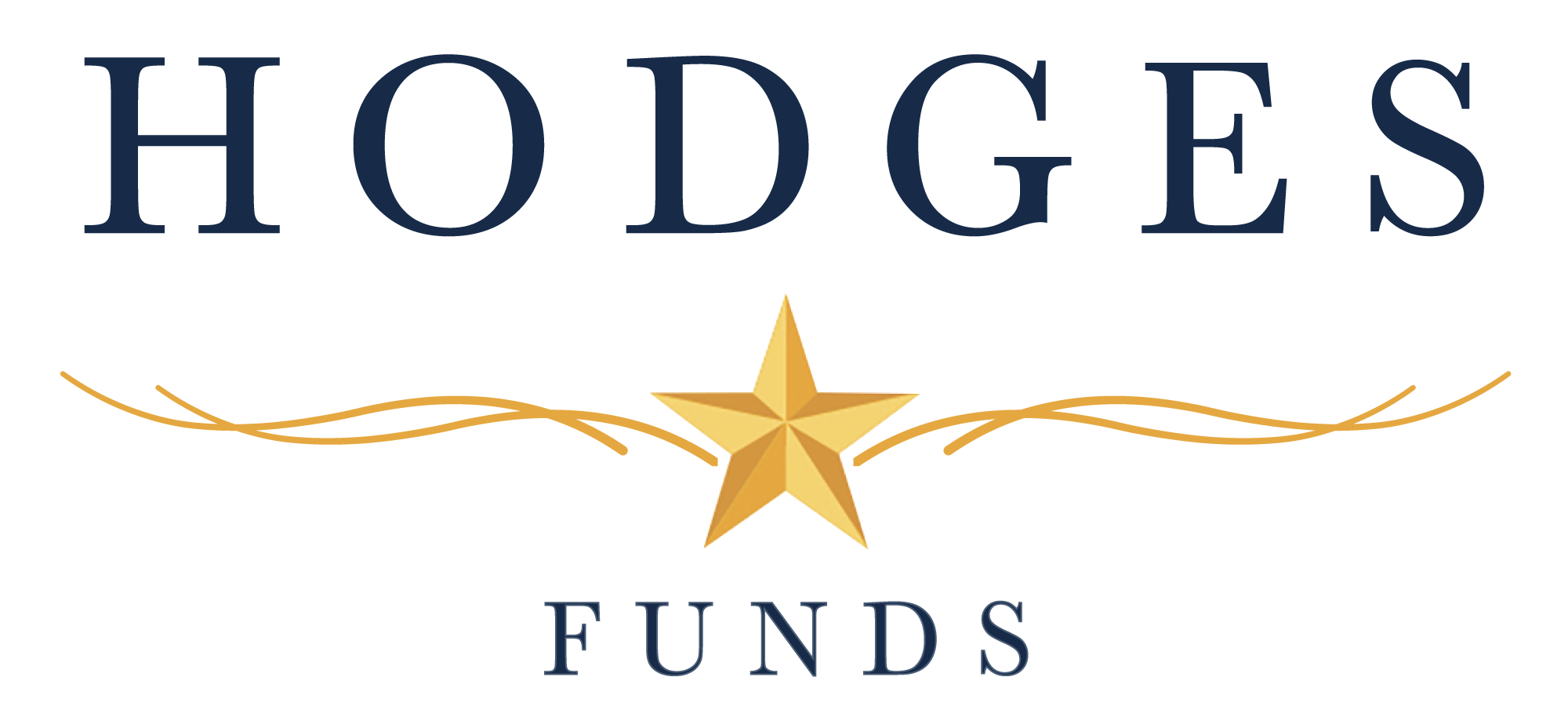First Quarter 2024 Review
by Eric Marshall, CFA, on Apr 15, 2024
Buy value, not market trends or economic outlook.” -Sir John Templeton.
It may be hard to believe, but the first quarter of 2024 resulted in the best start for the S&P 500 since 1950, with the broader market showing strength outside of technology stocks. The S&P 500 Index posted a gain of 10.56% in the recent quarter, with the number of stocks trading above their 200-day moving average to the highest level in three years at 85%. Investor sentiment seemed to improve throughout the recent quarter despite mixed signals surrounding the likelihood and timing of central bank interest rate cuts in 2024. Although trailing the S&P 500, small-caps, as measured by the Russell 2000, continued their rally in the recent quarter, increasing by 5.18%. Furthermore, we are pleased to report that all four Hodges Mutual Funds beat their respective benchmarks in the recent quarter. Positive relative performance in our fund strategies was primarily attributed to our steadfast focus on companies with sound business fundamentals and reasonable valuations.
In the first three months of 2024, we saw a healthy broadening of capital flows into sectors outside of mega-cap technology. This favored stocks with improving balance sheets, whose underlying assets can produce stable cash flow and earnings in a normalizing credit environment. As a result, the energy, industrial, financial, and materials sectors within the S&P 500 outperformed technology for a change. According to the most recent data published by FactSet, the S&P 500 traded at approximately 20.5X its forward earnings estimate at the end of March compared to 19.3X at the start of the year and its 5-year average of 19.1X. The inverse of the current S&P 500 PE multiple is an earnings yield of 4.88%, which was still above the 10-year treasury yield of 4.20% at the end of the recent quarter. It is worth acknowledging that PE multiples remain highly bifurcated between growth and value stocks.
For the balance of 2024, our investment team is laser-focused on the fundamentals of individual stock selection and the prospects for earnings power in the months ahead. While many economic pundits have predicted a U.S. recession for the past couple of years, a decline in real GDP for two consecutive quarters has not materialized. However, we have observed that specific sectors, such as financials, energy, and industrials, have already experienced an earnings recession or at least a significant contraction in profit margins over the past 18 months. Moreover, we now see the early signs of an earnings recovery for many economically sensitive stocks, especially within small caps, in the second half of 2024. Moreover, inflation appears to be moderating compared to this time a year ago, albeit at a slower pace than some predicted. Given the prospects for a more normalizing environment for inflation, we would not be surprised to see new leadership emerge within the domestic market or at least a broader number of stocks participating in any upside from earnings growth and PE multiple expansion.
Furthermore, we believe this is an ideal time to focus on quality stocks at a fair price rather than growth at any price, which is not always measured by market capitalization or reflected in market sentiment. We define quality as those well-managed companies with structural competitive advantages resulting from a differentiated niche, proprietary technology, or distinctive barrier to entry. Other factors include conservative balance sheets, low-cost operations, and ample liquidity to weather a downturn and, in many cases, take market share from weak competitors.
Our recent discussions with public company management teams over the past few months suggest that supply chains are stable for most industries, input costs have moderated, and demand remains healthy. Although the U.S. economy remains near full employment, consumer spending appears more erratic this year as low savings rates and higher credit card balances curtail discretionary consumption of some goods and services. The housing market is holding up better than feared in many regions due to a lack of existing homes for sale. Many small industrial companies that we have spoken with appear positioned to benefit from onshoring and nearshoring of supply chains and increased infrastructure-related spending. In this environment, active portfolio management becomes essential to navigate quickly changing business conditions across many sectors and position portfolios to potentially benefit from shifting economic trends and structural changes across different industries.
In summary, we are spending little time trying to predict short-term fluctuations in interest rates, foreign currencies, or commodity prices. Instead, we are paying close attention to prevailing trends and, more importantly, the earning power our portfolio companies exhibit within their distinctive businesses. As a result, the investment team at Hodges Capital is rigorously looking for undervalued companies that we believe are well-run and control their destiny by relying on ingenuity and well-calculated business decisions rather than day-to-day momentum in the stock market. Although many uncertainties exist surrounding the global economy and political landscape in 2024, we are overweighting our portfolios with growth and value stocks that we expect to create long-term shareholder value in today’s environment. In these uncertain times, we want to reassure Hodges Funds investors that our fundamental investment approach remains steadfast. Moreover, we view the current landscape as an opportune moment for our portfolio managers to meticulously handpick individual stocks that we believe will yield lasting value for our shareholders. Your trust in us means everything, and we are dedicated to upholding our investment discipline.
Returns (% Retail Class) as of 3/31/2024
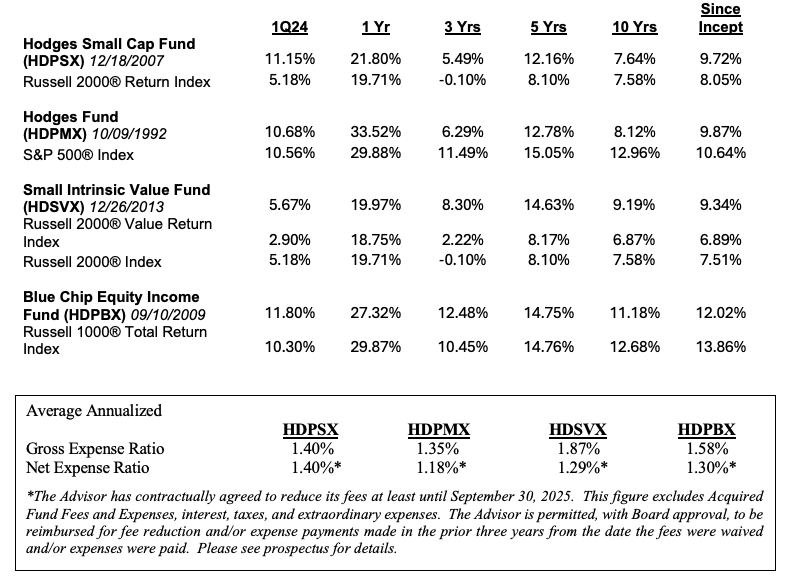
Performance data quoted represents past performance and does not guarantee future results. The investment return and principal value of an investment will fluctuate so that an investor's shares, when redeemed, may be worth more or less than their original cost. The current performance of the Funds may be lower or higher than the performance quoted. Performance data current to the most recent month-end may be obtained by calling 866-811-0224.
The Funds impose a 1.00% redemption fee on shares held for thirty days or less (60 days or less for Institutional Class shares). Performance data quoted does not reflect the redemption fee. If reflected, total returns would be reduced. Performance reflected is net of all other fees and expenses.
Hodges Small Cap Fund (HDPSX)
The return for the Hodges Small Cap Fund amounted to a gain of 11.15% in the first quarter of 2024, compared to an increase of 5.18% for the Russell 2000 Index. The Small Cap Fund's one-year performance amounted to a gain of 21.80% compared to 19.71% for the Russell 2000 Index during the same period. The Fund’s active return above the benchmark in the most recent quarter was 86% attributed to stock selection and 14% the result of sector allocation. The leading contributors to performance in the recent quarter included Eagle Materials Inc (EXP), ON Holding (ONON), Permian Resources (PR), and Cinemark Holdings (CNK). Although small-cap stocks underperformed large-cap stocks during the recent quarter, we still consider the current risk/reward for holding quality small-cap stocks attractive. While small-cap stocks tend to experience greater volatility during market turmoil, we expect this segment to generate above-average relative risk-adjusted returns over the long term.
The Hodges Small Cap Fund remains well diversified across industrials, transportation, healthcare, technology, and consumer-related names, which we expect to contribute to the Fund's long-term performance. The Fund recently took profits in several stocks that appeared overvalued relative to their underlying fundamentals and established new positions with an attractive risk/reward profile. The Fund had a total of 51 positions on March 31, 2024. The top ten holdings amounted to 36.84% of the Fund's holdings and included Matador Resources (MTDR), Encore Wire Corp (WIRE), Eagle Materials Inc (EXP), Cleveland-Cliffs Inc (CLF), Shoe Carnival Inc (SCVL), Taylor Morrison Home Corp (TMHC), Texas Pacific Land Corp (TPL), On Holding (ONON), Permian Resources (PR), and Topgolf Callaway Brands (MODG).

Hodges Fund (HDPMX)
The Hodges Fund's first quarter of 2024 return amounted to a gain of 10.68% compared to 10.56% for the S&P 500 Index. The fund's one-year performance amounted to a 33.52% gain as of March 31, 2024, compared to a 29.88% gain for the S&P 500 Index during the same period. Although the portfolio has been underweighted among the seven largest momentum stocks in the S&P 500, positive performance over the past twelve months has been attributed to stock selection in a broad range of industrial, energy, consumer discretionary, and technology stocks. The Hodges Fund’s turnover returned to normal in the recent quarter as we have carefully updated the portfolio holdings into stocks that we believe offer above-average returns relative to their downside risks over the next twelve to eighteen months. During the recent quarter, we added a new position to our top-ten holdings, DoubleVerify Holdings Inc (DV), which offers a innovative digital media measurement and analytics software platform.
The Hodges Fund's portfolio managers remain focused on investments where we have the highest conviction based on fundamentals and relative valuations. The number of positions held in the Fund at the end of the recent quarter was 38. On March 31, 2024, the top ten holdings represented 46.82% of the Fund's holdings. They included Matador Resources Co (MTDR), Uber Technologies (UBER), Encore Wire Corp (WIRE), DraftKings Inc (DKNG), Freeport McMoran Inc (FCX), Texas Pacific Land Corp (TPL), Cleveland-Cliffs Inc (CLF), Airbnb (ABNB), On Holding (ONON), and DoubleVerify Holdings Inc (DV).
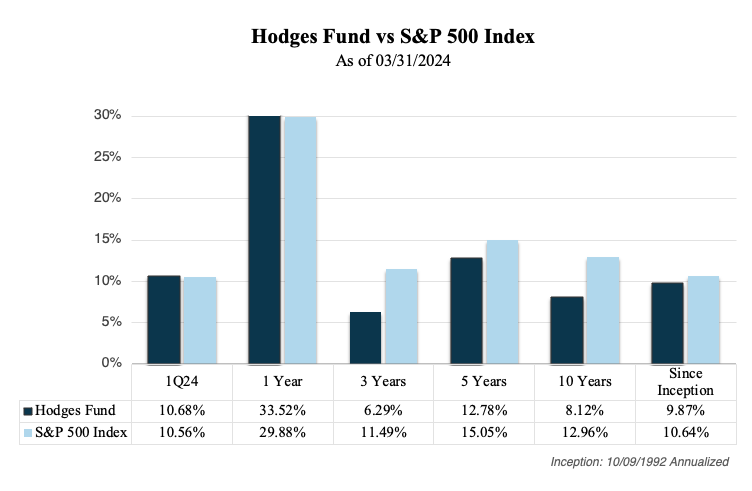
Hodges Small Intrinsic Value Fund (HDSVX)
The Hodges Small Intrinsic Value Fund experienced a gain of 5.67% in the first quarter of 2024 compared to an increase of 2.90 % for its benchmark, the Russell 2000 Value Index. The Fund’s one-year return amounted to 19.97% compared to 18.75% for the Russell 2000 Value Index. Recent outperformance relative to the benchmark was again entirely attributed to stock selection. Although a broad number of holdings contributed to the strategy's relative performance in the quarter, we believe it is also worth noting that the top three stocks that contributed to performance in the first quarter were also the top three stocks in terms of weighting to the portfolio. The number of positions held in the Fund increased by two, resulting in 50 holdings at the end of the recent quarter. On March 31, 2024, the top holdings represented 35.83% of the Fund's holdings. They included Eagle Materials Inc (EXP), Shoe Carnival Inc (SCVL), SunOpta (STKL), Triumph Financial (TFIN), Ethan Allen Interiors Inc (ETD), Aviat Networks (AVNW), Cleveland-Cliffs Inc (CLF), Banc of California (BANC), and Taylor Morrison Home Corp (TMHC).
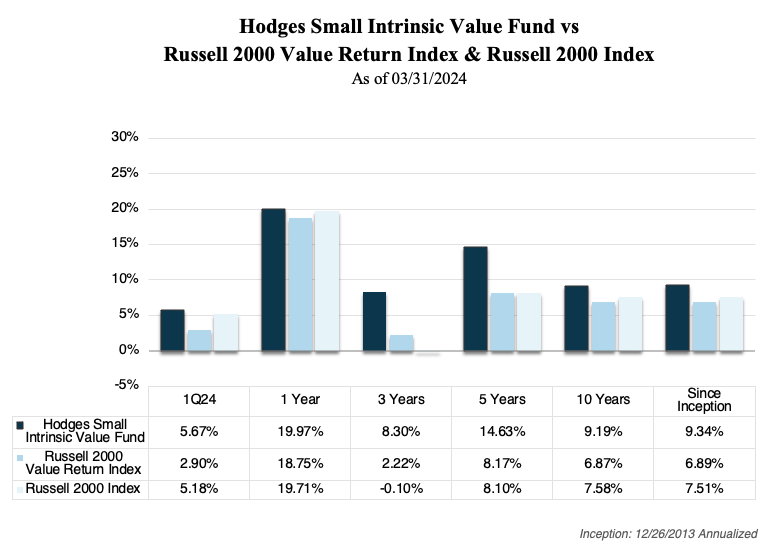
Hodges Blue Chip Equity Income Fund (HDPBX)
The Hodges Blue Chip Equity Income Fund was up 11.80% in the first quarter of 2024, compared to 10.30% for its benchmark, the Russell 1000 Total Return Index. The Fund experienced a one-year return of 27.32% compared to 29.87% for the Russell 1000 Total Return Index. Positive relative performance in the recent quarter and the year was attributed to stock selection versus sector allocation. Nvidia (NVDA) and Taiwan Semiconductor (TSM) were among the stocks that contributed to improved relative performance in the first quarter.
We believe the current investment landscape offers ample opportunities among high-quality, dividend-paying stocks with solid upside potential. We expect underleveraged balance sheets and corporate profits across most blue-chip stocks to support stable dividends over the next several years. The Blue Chip Equity Income Fund remains well-diversified in companies that we believe can generate above-average income and total returns on a risk-adjusted basis. The number of positions held in the Fund at the end of the recent quarter was 28. The top ten holdings at the end of the quarter represented 46.42% of the Fund's holdings and included Microsoft Corp (MSFT), Nvidia (NVDA), Apple Inc (AAPL), Goldman Sachs Group Inc (GS), Costco Wholesale (COST), JP Morgan (JPM), Exxon Mobil (XOM), Deere & Co (DE), Taiwan Semiconductor (TSM), and Walmart Inc (WMT).
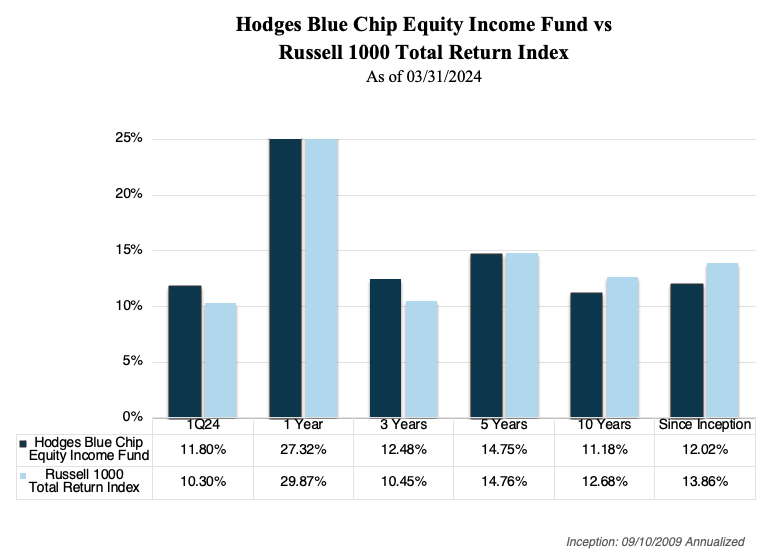
In conclusion, we remain optimistic regarding the long-term investment opportunities surrounding the Hodges Mutual Funds. By offering four distinct mutual fund strategies covering most segments of the domestic equity market, we can serve most financial advisors and individual investors' diverse needs. Moreover, our entire investment team is highly committed to rigorously studying companies, meeting with management teams, and observing trends to navigate today's ever-changing financial markets. Feel free to contact us directly if we can address any specific questions.
The above discussion is based on the opinions of Eric Marshall, CFA, and is subject to change. It is not intended to be a forecast of future events, a guarantee of future results, and is not a recommendation to buy or sell any security. Portfolio composition and company ownership in the Hodges Funds are subject to daily change.
The Fund’s investment objectives, risks, charges and expenses must be considered carefully before investing. The statutory and summary prospectuses contain this and other important information about the Hodges Funds, and it may be obtained by calling 866-811-0224, or visiting www.hodgesmutualfunds.com. Read it carefully before investing.
Mutual fund investing involves risk. Principal loss is possible. Investments in foreign securities involve greater volatility and political, economic and currency risks and differences in accounting methods. These risks are greater for investments in emerging markets. Options and future contracts have the risks of unlimited losses of the underlying holdings due to unanticipated market movements and failure to correctly predict the direction of securities prices, interest rates and currency exchange rates. These risks may be greater than risks associated with more traditional investments. Short sales of securities involve the risk that losses may exceed the original amount invested. Investments in debt securities typically decrease in value when interest rates rise. This risk is usually greater for longer term debt securities. Investments in small and medium capitalization companies involve additional risks such as limited liquidity and greater volatility. Funds that are non-diversified are more exposed to individual stock volatility than a diversified fund. Investments in companies that demonstrate special situations or turnarounds, meaning companies that have experienced significant business problems but are believed to have favorable prospects for recovery, involve greater risk.
Value investing carries the risk that the market will not recognize a security’s inherent value for a long time, or that a stock judged to be undervalued may be appropriately priced or overvalued.
Diversification does not assure a profit or protect against a loss in a declining market.
Fund holdings and/or sector allocations are subject to change at any time and are not recommendations to buy or sell any security.
Investment performance reflects fee waivers in effect. In the absence of such waivers, total return would be reduced.
The S&P 500 Index is a broad-based unmanaged index of 500 stocks that is widely recognized as representative of the equity market in general. The Russell 1000 Index is a subset of the Russell 3000 Index and consists of the 1,000 largest companies comprising over 90% of the total market capitalization of all listed stocks. The Russell 2000 Index consists of the smallest 2,000 companies in a group of 3,000 U.S. companies in the Russell 3000 Index, as ranked by market capitalization. The Russell 2500 Index consists of the smallest 2,500 companies in a group of 3,000 U.S. companies in the Russell 3000 Index, as ranked by market capitalization. The Russell 3000 Index is a stock index consisting of the 3000 largest publicly listed companies, representing about 98% of the total capitalization of the entire U.S. stock market. The Russell 2000 Value Index measures the performance of small-cap value segment of the U.S. equity universe. It includes those Russell 2000 companies with lower price-to-book ratios and lower forecasted growth values. The Russell 2000 Value Index is constructed to provide a comprehensive and unbiased barometer for the small-cap value segment. The Index is completely reconstituted annually to ensure larger stocks do not distort the performance and characteristics of the true small-cap opportunity set and that the represented companies continue to reflect value characteristics. The NASDAQ Composite Index is an index of more than 3,000 common equities listed on the NASDAQ stock market. You cannot invest directly into an index.
Cash Flow: A revenue or expense stream that changes a cash account over a given period.
Price/earnings (P/E): The most common measure of how expensive a stock is.
Earnings Growth is not a measure of the Fund’s future performance.
Hodges Capital Management is the Advisor to the Hodges Funds.
Hodges Funds are distributed by Quasar Distributors LLC.
18028767-NLD 04/11/2024


